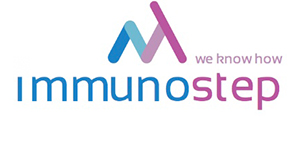CD3/CD16+CD56
CD3/CD16+56, Monoclonal, IgG1, Host: Mouse, FITC/PE
SKU
IMS3F11656PE-50T
Packaging Unit
50 Tests
Manufacturer
Immunostep
Availability:
loading...
Price is loading...
Clone: 33-2A3/GRM1+B-A19.
Conjugate: FITC/PE+PE.
Storage Buffer: PBS, 0,09% sodium Azide, may contain carrier protein-stabilizer.
Description: Reactivity: The CD3 monoclonal antibody is directed against the CD3- antigen (T3-antigen), which is expressed on human T lymphocytes. The monoclonal antibody reacts with 80-90% human peripheral T lymphocytes and medullary thymocytes. The monoclonal antibody does not react with B-cells, monocytes, granulocytes and platelets. The monoclonal antibody is mitogenic for resting T lymphocytes and it blocks the cytolytic activity of CTL clones.
The CD3 monoclonal antibody is directed against the CD3- antigen (T3-antigen), which is expressed on human T lymphocytes. The monoclonal antibody reacts with 80-90% human peripheral T lymphocytes and medullary thymocytes. The monoclonal antibody does not react with B-cells, monocytes, granulocytes and platelets. The monoclonal antibody is mitogenic for resting T lymphocytes and it blocks the cytolytic activity of CTL clones.This CD16 PE, clone 3G8 monoclonal antibody reacts with human and non-human primate CD16, which is also known as the low-affinity FcγRIII. CD16 exists as two distinct isoforms, FcγRIIIA and FcγRIIIB. In humans, FcγRIIIA is expressed as a polypeptide-anchored form on monocytes, macrophages, and lymphocytes such as NK cells. T and B cells do not express this Fc receptor. FcγRIIIB is also detected on neutrophils as a GPI-anchored form. Expression of CD16 on lymphocytes and monocytes is similar in non-human primates. However, while CD16 is not found on neutrophils in macaques and baboons, this receptor is detected on these cells in sooty mangabeys. Binding of IgG leads to activation of signal transduction pathways, resulting in antibody-dependent cell-mediated cytotoxicity (ADCC), phagocytosis, cytokine release, and antigen presentation
Conjugate: FITC/PE+PE.
Storage Buffer: PBS, 0,09% sodium Azide, may contain carrier protein-stabilizer.
Description: Reactivity: The CD3 monoclonal antibody is directed against the CD3- antigen (T3-antigen), which is expressed on human T lymphocytes. The monoclonal antibody reacts with 80-90% human peripheral T lymphocytes and medullary thymocytes. The monoclonal antibody does not react with B-cells, monocytes, granulocytes and platelets. The monoclonal antibody is mitogenic for resting T lymphocytes and it blocks the cytolytic activity of CTL clones.
The CD3 monoclonal antibody is directed against the CD3- antigen (T3-antigen), which is expressed on human T lymphocytes. The monoclonal antibody reacts with 80-90% human peripheral T lymphocytes and medullary thymocytes. The monoclonal antibody does not react with B-cells, monocytes, granulocytes and platelets. The monoclonal antibody is mitogenic for resting T lymphocytes and it blocks the cytolytic activity of CTL clones.This CD16 PE, clone 3G8 monoclonal antibody reacts with human and non-human primate CD16, which is also known as the low-affinity FcγRIII. CD16 exists as two distinct isoforms, FcγRIIIA and FcγRIIIB. In humans, FcγRIIIA is expressed as a polypeptide-anchored form on monocytes, macrophages, and lymphocytes such as NK cells. T and B cells do not express this Fc receptor. FcγRIIIB is also detected on neutrophils as a GPI-anchored form. Expression of CD16 on lymphocytes and monocytes is similar in non-human primates. However, while CD16 is not found on neutrophils in macaques and baboons, this receptor is detected on these cells in sooty mangabeys. Binding of IgG leads to activation of signal transduction pathways, resulting in antibody-dependent cell-mediated cytotoxicity (ADCC), phagocytosis, cytokine release, and antigen presentation
| SKU | IMS3F11656PE-50T |
|---|---|
| Manufacturer | Immunostep |
| Manufacturer SKU | 3F11656PE-50T |
| Package Unit | 50 Tests |
| Quantity Unit | PAK |
| Reactivity | Human |
| Clonality | Monoclonal |
| Application | Flow Cytometry |
| Isotype | IgG1, IgG2a |
| Host | Mouse |
| Conjugate | Unconjugated |
| Product information (PDF) | Download |
| MSDS (PDF) | Download |

 Deutsch
Deutsch






